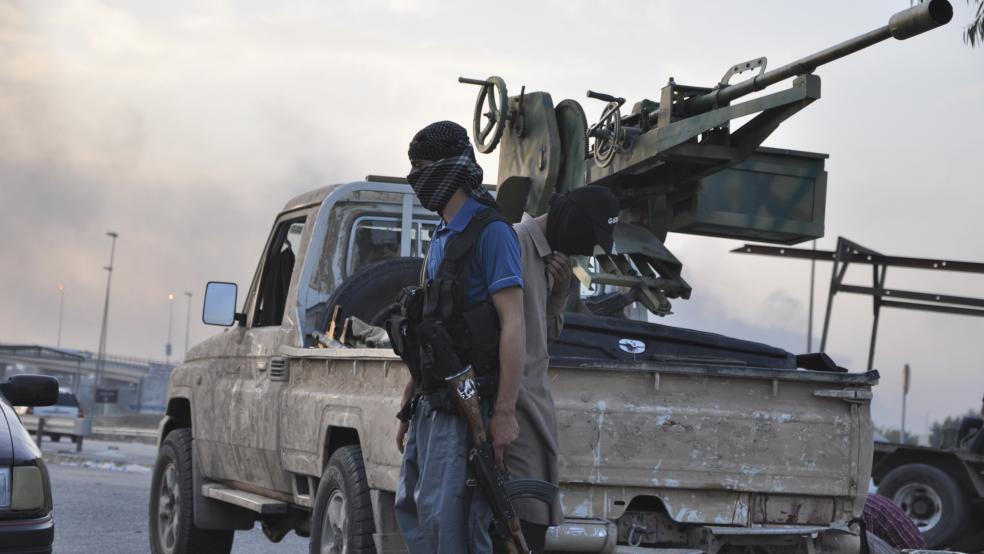Last month, while the world was busy watching ISIS advance to the Syrian city of Kobani, Houthi rebels seized control of Yemeni capital Sana’a. The Houthis are a religious Zaidi Shia movement with an armed wing, similar to the Sadr movement in Iraq and Hezbollah in Lebanon. As the rebels continued their advance, 250 people were killed last weekend in clashes between the rebels and a tribe allied with al-Qaeda.
Experts say the Houthi advance into Sana’a and beyond is a further sign Yemen is descending into a sectarian civil war that will only add to the instability in the Middle East — and could ultimately provide a stronger base for al-Qaeda and ISIS, as well as a common enemy that may bring those two terror groups together.
Related: If ISIS Captures Baghdad, Terror Takes a Giant Step Forward
“All the ingredients for a civil war in Yemen are amassed and merging: a fragile government, a divided society, regional rivalry, a history of violence, etc. Furthermore, the Houthi rebels in recent weeks extended their control of areas that are far from their popular base,” said Massaab Al-Aloosy, a Middle Eastern Affairs analyst and former researcher at the World Peace Foundation in Massachusetts.
The U.S. has waged a decade-long drone war in Yemen, but a civil war in the country could raise the risks to the U.S. homeland.
The developments in Yemen echo Iraq in 2006 and 2014 and Syria in 2012, where the Sunni population felt threatened by dominant Shiite militias, creating a receptive hub for the terror groups.
Al-Qaeda in Yemen — now called al-Qaeda in the Arabian Peninsula (AQAP) after merging with al-Qaeda in Saudi Arabia — is already considered the most dangerous terrorist organization to the U.S. The last several attempts to attack the U.S. were conducted by its operatives, or by people who were inspired by its leaders. The U.S. has waged a decade-long drone war in Yemen, but a civil war in the country could raise the risks to the U.S. homeland.
Among those risks, the current escalation in sectarian violence in Yemen may lead to more al-Qaeda cooperation with ISIS to fight the common Shiite enemy. “I think it is very possible for al-Qaeda to work with ISIS and even with Al Islah Party (the Muslim Brotherhood) to defeat Houthis, not only because it makes sense — they share the same enemy — but because Mohammed Al-Yadomi, leader of Al-Islah party declared the upcoming emergence of ISIS in Yemen and demanded political forces in Yemen to welcome ISIS,” said Ghada Al-Wazeer, a Yemeni American and the former Yemen coordinator at MasterPeace, an international organization based in Cairo that promotes peace in conflict zones.
Some experts think that an ISIS-AQAP alliance has already been formed. “Al-Qaeda in the Arabian Peninsula recently expressed support for fighters in Iraq and Syria against attacks by the U.S.-led coalition,” says Jasmine Opperman, a researcher at the Terrorism Research and Analysis Consortium in Florida. “Of greater significance is that AQAP also called for unity as to enable a united front and in the statement referred to IS fighters as ‘brothers.’ This statement tells us that cooperation in Yemen against a common enemy is already at play and to include the U.S. coalition attacks in the statement is the ideal opportunity to call for unity that will justify cooperation within Yemen.”
“The U.S. and the West are faced with a unified jihadist threat that has a capacity not seen before in the history of terrorism. Yemen truly provides the key to this new threat.”
Such cooperation could also result in an even more significant terrorist threat to the U.S. “The U.S. and the West, as well as those living inside the region, are faced with a unified jihadist threat that has a capacity and a reach of consolidated support not seen before in the history of terrorism. Yemen truly provides the key to this new threat,” says Opperman.
Related: The Merger of ISIS and al-Qaeda Could Cripple the Civilized World
Experts portray the increasing sectarian violence in Yemen as part of the larger divide that is currently tearing the Middle East apart. The Houthis have been involved in a decade-long insurgency in northern Yemen, where the population of 25 million is roughly 60 percent Sunnis and 40 percent Shiites. Both sects have ruled the country at times throughout the last 14 centuries.

“It is essential to understand strategically how the map of the Middle East is being redrawn by sectarian violence,” says Professor Colette Mazzucelli of New York University, who specializes in Middle Eastern affairs. “As the Shia Houthi expand their control of Yemen’s territory further south, the Houthi alignment with Tehran, Damascus, Baghdad, and Hezbollah poses a threat to an area dominated by Sunnis. The potential for a clash between the Houthi militants and al-Qaeda in the Arabian Peninsula is rising, which could plunge Yemen into sectarian civil war.”
Some say the country is already there. Ghada Al-Wazeer, the Yemeni American, is one of them. “Current events in Yemen all come under what we call a civil war,” she says.
“AQAP members are fighting alongside Sunnis under the name ‘Sunni tribes’ in Ibb, Rada’a, Dhamar and Al Bayda to defeat Houthis. The suicide bombing which killed at least 50 people in Sana’a during the Houthi rally also makes the existence of a civil war undeniable. These groups are all oriented along sectarian lines and aim to seize control through violence and armed rebellion. This alone increases the chances of more conflict,” Al-Wazeer said.
AQAP has started to extend its influence into new areas, forging new alliances with tribes also aligned against the Houthis.
A HISTORY OF CONFLICT
Yemen has been in turmoil for years. In January 2011, a revolution broke out as part of the Arab Spring. The country’s youth rose up against former dictator Ali Abdullah Salih, who had ruled the country since 1978. Salih had allowed al-Qaeda to gain a foothold in the country as part of a strategy to hold onto power. A secular Shiite, Salih had used the Muslim Brotherhood, the tribes, his own party, and sometimes al-Qaeda against the Houthis in the north and the separatists in the south to ensure the continuity of his family’s reign.
That strategy couldn’t survive the upheaval of the Arab Spring. Salih stepped down in February 2012, ceding office to his vice president in return for immunity from prosecution. After the Salih government fell, establishing a governable peace was a primary goal for new President Abd Rabbuh Mansur Hadi. Hadi, a Sunni, held a national conference in March 2013 to bring all different factions to one table. In January 2014, they agreed to draft a new constitution that would make Yemen a federal country with more power to the provinces, in theory inclusive of all groups and encouraging their participation.
Related: Drone Strikes Kill Three al-Qaeda Militants
Difficult economic conditions thwarted those plans. In August 2014, the Yemeni government decided to lift its subsidies on fuel. With about half of Yemenis below the poverty line, the Houthi rebels protested the decision and advanced toward the capital, Sana’a. The rebels installed tents and arranged sit-ins, in addition to engaging the army in battles.
On September 21, the Houthis captured Sana’a with little resistance from the army, forcing the Hadi government to resign.
SECTARIAN SPLITS
The advancing Houthi rebellion is shifting traditional alliances and leading to new ones. The rebels began targeting opponents in the ranks of the army, the Sunni tribes, and the Muslim Brotherhood. In return, Sunni tribes, the Brotherhood, and AQAP began fighting the Houthis together. The Houthis were also helped by supporters of former dictator Salih who still enjoys significant influence in the army and in politics, and were sanctioned by the U.N. Security Council for being an obstacle to democratic reform in Yemen.
As a result AQAP has started to extend its influence into new areas, forging new alliances with tribes also aligned against the Houthis, said Opperman.
As happened in Iraq and Syria before, the escalating sectarian violence in Yemen might increase the recruitment to al-Qaeda from the Middle East, Europe and other parts of the world. “The current fight in Yemen will re-align the leadership hierarchy of AQAP,” says Fernando Carvajal, a Yemeni affairs specialist at the University of Exeter (UK).
Related: 9 ISIS Weapons That Will Shock You
In 2011, AQAP and other groups established an umbrella organization called “Ansar al-Sharia,” or the supporters of Islamic Law. The organization sees Yemen as key to its future. “Ansar al-Sharia elements want to prioritize the fight in Yemen, not only to establish safehavens for the group but also to reposition themselves within the global jihadist movement. Framing the fight in Yemen as a sectarian war on apostates (Houthis) is part of the strategy to expose the work by the group internationally and gain world exposure,” Carvajal says.
“If the spiritual leader of Ansar al-Sharia, Ma’moon Abdulhamid Hatem, manages to lead a successful campaign against the Houthis, it will contribute to his public persona and become a new center of gravity for jihadists.”
Top Reads from The Fiscal Times:





